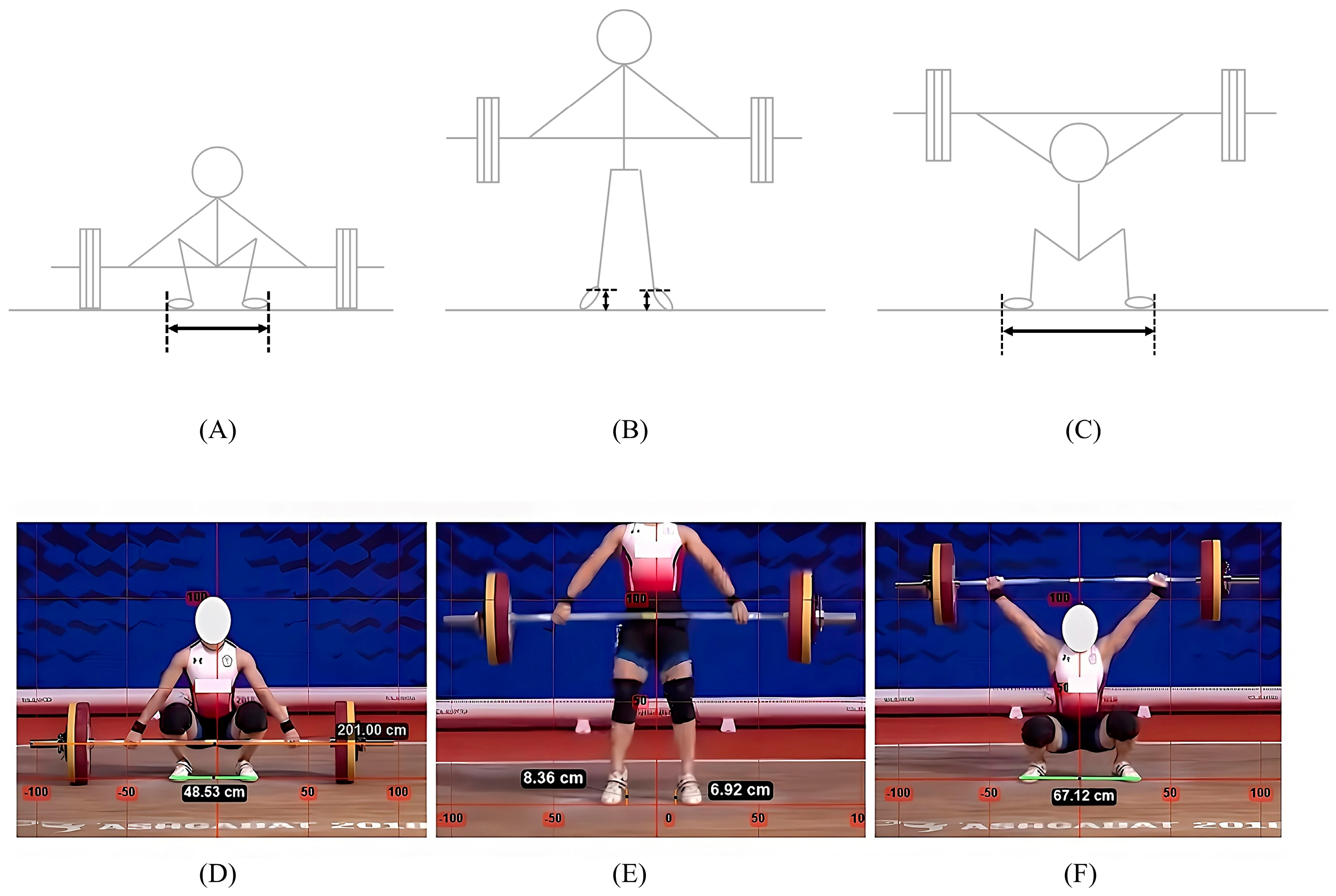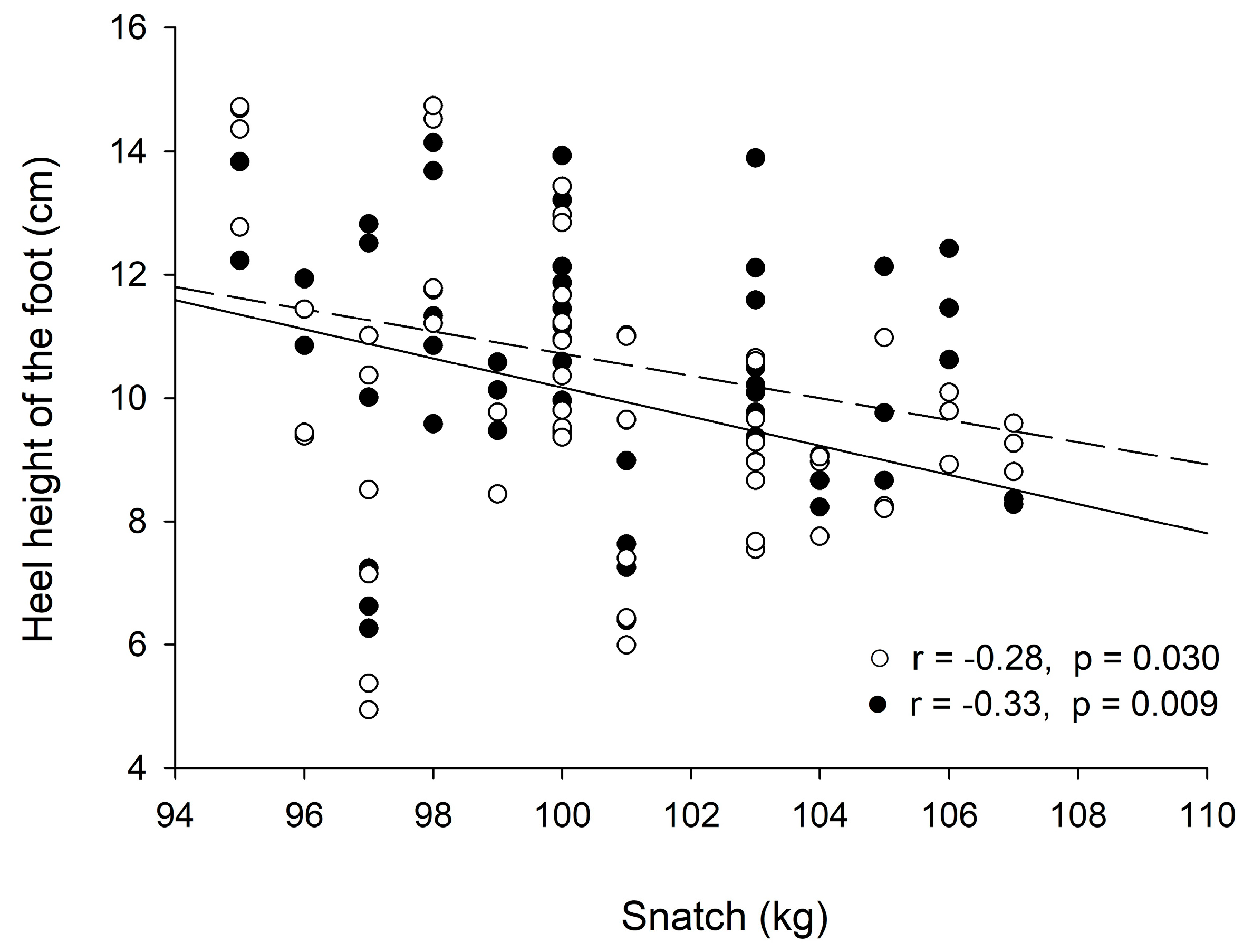Foot Kinematics of Elite Female 59 kg Weightlifters in the 2018–2021 World Championships
Abstract
1. Introduction
2. Materials and Methods
2.1. Experimental Approach to the Problem
2.2. Procedures and Video Analysis
2.3. Statistical Analysis
3. Results
4. Discussion
Limitations
5. Conclusions
Author Contributions
Funding
Institutional Review Board Statement
Informed Consent Statement
Data Availability Statement
Acknowledgments
Conflicts of Interest
References
- Garhammer, J. A Review of Power Output Studies of Olympic and Powerlifting: Methodology, Performance Prediction, and Evaluation Tests. J. Strength Cond. Res. 1993, 7, 76–89. [Google Scholar] [CrossRef]
- Garhammer, J.; Komi, P. Weightlifting performance and techniques of men and women. In Proceedings of the Proceedings from the International Conference on Weightlifting and Strength Training, Lahty, Finland, 10–12 November 1998; pp. 89–94. [Google Scholar]
- Hoover, D.L.; Carlson, K.M.; Christensen, B.K.; Zbeas, C.J. Biomechanical Analysis of Women Weighlifters During the Snatch. J. Strength Cond. Res. 2006, 20, 627–633. [Google Scholar] [PubMed]
- Gourgoulis, V.; Aggeloussis, N.; Antoniou, P.; Christoforidis, C.; Mavromatis, G.; Garas, A. Comparative 3-Dimensional Kinematic Analysis of the Snatch Technique in Elite Male and Female Greek Weightlifters. J. Strength Cond. Res. 2002, 16, 359–366. [Google Scholar] [CrossRef]
- Hoffman, J.R.; Cooper, J.; Wendell, M.; Kang, J. Comparison of Olympic vs. traditional power lifting training programs in football players. J. Strength Cond. Res. 2004, 18, 129–135. [Google Scholar] [CrossRef] [PubMed][Green Version]
- Suchomel, T.J.; Comfort, P.; Lake, J.P. Enhancing the Force-Velocity Profile of Athletes Using Weightlifting Derivatives. Strength Cond. J. 2017, 39, 10–20. [Google Scholar] [CrossRef]
- Otto, W.H.I.; Coburn, J.W.; Brown, L.E.; Spiering, B.A. Effects of Weightlifting vs. Kettlebell Training on Vertical Jump, Strength, and Body Composition. J. Strength Cond. Res. 2012, 26, 1199–1202. [Google Scholar] [CrossRef]
- Wang, S.-Y.; Lan, P.-T.; Hsu, T.-G. Learning effects of triple continuous jumping snatch intervention on the second pull of the snatch for novice lifters. Int. J. Sports Sci. Coach. 2023, 18, 1577–1584. [Google Scholar] [CrossRef]
- Suchomel, T.; Comfort, P.; Stone, M. Weightlifting Pulling Derivatives: Rationale for Implementation and Application. Sports Med. 2015, 45, 823–839. [Google Scholar] [CrossRef]
- Olaya Mira, N.; Soto Cardona, I.; Palacio-Peña, R.; Acevedo-Tangarife, N. Kinematic Analysis of the Snatch Technique in High Performance Weightlifters. Apunt. Educ. Física Y Deportes 2020, 2, 70–76. [Google Scholar] [CrossRef]
- AkkuS, H. Kinematic Analysis of the Snatch Lift With Elite Female Weightlifters During the 2010 World Weightlifting Championship. J. Strength Cond. Res. 2012, 26, 897–905. [Google Scholar] [CrossRef]
- Korkmaz, S.; Harbili, E. Biomechanical analysis of the snatch technique in junior elite female weightlifters. J. Sports Sci. 2016, 34, 1088–1093. [Google Scholar] [CrossRef] [PubMed]
- Hawrylak, A.; Gronowska, H. Plantar Pressure Distribution in Female Olympic-Style Weightlifters. Int. J. Environ. Res. Public Health 2020, 17, 2669. [Google Scholar] [CrossRef] [PubMed]
- Peres, A.B.; Sancassani, A.; Castro, E.A.; Almeida, T.A.F.; Massini, D.A.; Macedo, A.G.; Espada, M.C.; Hernández-Beltrán, V.; Gamonales, J.M.; Pessôa Filho, D.M. Comparing Video Analysis to Computerized Detection of Limb Position for the Diagnosis of Movement Control during Back Squat Exercise with Overload. Sensors 2024, 24, 1910. [Google Scholar] [CrossRef] [PubMed]
- Werner, I.; Szelenczy, N.; Wachholz, F.; Federolf, P. How Do Movement Patterns in Weightlifting (Clean) Change When Using Lighter or Heavier Barbell Loads?—A Comparison of Two Principal Component Analysis-Based Approaches to Studying Technique. Front. Psychol. 2021, 11, 606070. [Google Scholar] [CrossRef]
- Nor Adnan, N.M.; Ab Patar, M.N.A.; Lee, H.; Yamamoto, S.-I.; Jong-Young, L.; Mahmud, J. Biomechanical analysis using Kinovea for sports application. IOP Conf. Ser. Mater. Sci. Eng. 2018, 342, 012097. [Google Scholar] [CrossRef]
- Cunanan, A.J.; Hornsby, W.G.; South, M.A.; Ushakova, K.P.; Mizuguchi, S.; Sato, K.; Pierce, K.C.; Stone, M.H. Survey of Barbell Trajectory and Kinematics of the Snatch Lift from the 2015 World and 2017 Pan-American Weightlifting Championships. Sports 2020, 8, 118. [Google Scholar] [CrossRef]
- Kong, P.W.; Sim, A.; Chiam, M.J. Performing Meaningful Movement Analysis From Publicly Available Videos Using Free Software—A Case of Acrobatic Sports. Front. Educ. 2022, 7, 885853. [Google Scholar] [CrossRef]
- Luxem, K.; Sun, J.J.; Bradley, S.P.; Krishnan, K.; Yttri, E.; Zimmermann, J.; Pereira, T.D.; Laubach, M. Open-source tools for behavioral video analysis: Setup, methods, and best practices. eLife 2023, 12, e79305. [Google Scholar] [CrossRef]
- International Weightlifting Federation—Technical and Competition Rules 2024. Available online: https://iwf.sport/wp-content/uploads/downloads/2024/08/IWF-TCRR-2024.pdf (accessed on 11 October 2024).
- Ashgabat 2018 Highlights|Women 59kg. Available online: https://www.youtube.com/watch?v=2ZAsV3cSwMM&t=44s (accessed on 2 October 2023).
- Hopkins, W.G. Measures of Reliability in Sports Medicine and Science. Sports Med. 2000, 30, 1–15. [Google Scholar] [CrossRef]
- Mizutori, H.; Kashiwagi, Y.; Hakamada, N.; Tachibana, Y.; Funato, K. Kinematics and joints moments profile during straight arm press to handstand in male gymnasts. PLoS ONE 2021, 16, e0253951. [Google Scholar] [CrossRef]
- Chavda, S.; Hill, M.; Martin, S.; Swisher, A.; Haff, G.G.; Turner, A.N. Weightlifting: An Applied Method of Technical Analysis. Strength Cond. J. 2021, 43, 32–42. [Google Scholar] [CrossRef]
- Gourgoulis, V.; Aggeloussis, N.; Garas, A.; Mavromatis, G. Unsuccessful vs. Success. Perform. Snatch Lifts: A Kinematic Approach. J. Strength Cond. Res. 2009, 23, 486–494. [Google Scholar] [CrossRef] [PubMed]
- Lauder, M.A.; Lake, J.P. Biomechanical Comparison of Unilateral and Bilateral Power Snatch Lifts. J. Strength Cond. Res. 2008, 22, 653–660. [Google Scholar] [CrossRef] [PubMed]
- Musser, L.J.; Garhammer, J.; Rozenek, R.; Crussemeyer, J.A.; Vargas, E.M. Anthropometry and barbell trajectory in the snatch lift for elite women weightlifters. J. Strength Cond. Res. 2014, 28, 1636–1648. [Google Scholar] [CrossRef] [PubMed]
- Nagao, H.; Kubo, Y.; Tsuno, T.; Kurosaka, S.; Muto, M. A biomechanical comparison of successful and unsuccessful snatch attempts among elite male weightlifters. Sports 2019, 7, 151. [Google Scholar] [CrossRef] [PubMed]
- Myer, G.D.; Kushner, A.M.; Brent, J.L.; Schoenfeld, B.J.; Hugentobler, J.; Lloyd, R.S.; Vermeil, A.; Chu, D.A.; Harbin, J.; McGill, S.M. The Back Squat: A Proposed Assessment of Functional Deficits and Technical Factors That Limit Performance. Strength Cond. J. 2014, 36, 4–27. [Google Scholar] [CrossRef]
- RADIN, E.L. Biomechanics of the human hip. Clin. Orthop. Relat. Res. 1980, 152, 28–34. [Google Scholar] [CrossRef]
- Suehiro, T.; Mizutani, M.; Ishida, H.; Kobara, K.; Fujita, D.; Osaka, H.; Takahashi, H.; Watanabe, S. Effect of abduction and external rotation of the hip joint on muscle onset time during prone hip extension with knee flexion. J. Phys. Ther. Sci. 2015, 27, 289–291. [Google Scholar] [CrossRef][Green Version]
- Cook, G. Athletic Body in Balance; Human kinetics: Champaign, IL, USA, 2003. [Google Scholar]
- Morrow, J.R.J.; Hosler, W.W. Strength comparisons in untrained men and trained women athletes. Med. Sci. Sports Exerc. 1981, 13, 194–197. [Google Scholar] [CrossRef]


| Athletes | Age (Year) | Body Weight (kg) | Height (cm) | Best Result (kg) |
|---|---|---|---|---|
| A | 25 | 58.07 | 155 | 105 |
| B | 20 | 58.70 | 160 | 103 |
| C | 26 | 58.95 | 159 | 107 |
| D | 26 | 58.55 | 155 | 106 |
| E | 25 | 58.85 | 157 | 101 |
| F | 21 | 58.90 | 155 | 101 |
| G | 28 | 58.80 | 155 | 100 |
| H | 25 | 58.80 | 157 | 100 |
| Mean ± SD | 24.50 ± 2.50 | 58.70 ± 0.27 | 156.63 ± 1.87 | 102.88 ± 2.62 |
| Lifted Weight | Foot Distance (Start Phase) | Foot Distance (Catch Phase) | Sideway Displacement | Maximum Heel Height (Right) | Maximum Heel Height (Left) | |
|---|---|---|---|---|---|---|
| Lifted weight | −0.135 | −0.467 ** | −0.275 * | −0.280 * | −0.332 ** | |
| Foot distance (start phase) | −0.135 | 0.262 * | −0.603 ** | 0.084 | 0.194 | |
| Foot distance (catch phase) | −0.467 ** | 0.262 * | 0.612 ** | 0.394 ** | 0.486 ** | |
| Sideway displacement | −0.275 * | −0.603 ** | 0.612 ** | 0.257 * | 0.243 | |
| Maximum heel height (right) | −0.280 * | 0.084 | 0.394 ** | 0.257 * | 0.853 ** | |
| Maximum heel height (left) | −0.332 ** | 0.194 | 0.486 ** | 0.243 | 0.853 ** |
Disclaimer/Publisher’s Note: The statements, opinions and data contained in all publications are solely those of the individual author(s) and contributor(s) and not of MDPI and/or the editor(s). MDPI and/or the editor(s) disclaim responsibility for any injury to people or property resulting from any ideas, methods, instructions or products referred to in the content. |
© 2024 by the authors. Licensee MDPI, Basel, Switzerland. This article is an open access article distributed under the terms and conditions of the Creative Commons Attribution (CC BY) license (https://creativecommons.org/licenses/by/4.0/).
Share and Cite
Yan, W.-C.; Lan, P.-T.; Wu, C.-F.; Hu, W.-P. Foot Kinematics of Elite Female 59 kg Weightlifters in the 2018–2021 World Championships. J. Funct. Morphol. Kinesiol. 2024, 9, 207. https://doi.org/10.3390/jfmk9040207
Yan W-C, Lan P-T, Wu C-F, Hu W-P. Foot Kinematics of Elite Female 59 kg Weightlifters in the 2018–2021 World Championships. Journal of Functional Morphology and Kinesiology. 2024; 9(4):207. https://doi.org/10.3390/jfmk9040207
Chicago/Turabian StyleYan, Wei-Cian, Pei-Tzu Lan, Chia-Fang Wu, and Wen-Pin Hu. 2024. "Foot Kinematics of Elite Female 59 kg Weightlifters in the 2018–2021 World Championships" Journal of Functional Morphology and Kinesiology 9, no. 4: 207. https://doi.org/10.3390/jfmk9040207
APA StyleYan, W.-C., Lan, P.-T., Wu, C.-F., & Hu, W.-P. (2024). Foot Kinematics of Elite Female 59 kg Weightlifters in the 2018–2021 World Championships. Journal of Functional Morphology and Kinesiology, 9(4), 207. https://doi.org/10.3390/jfmk9040207







